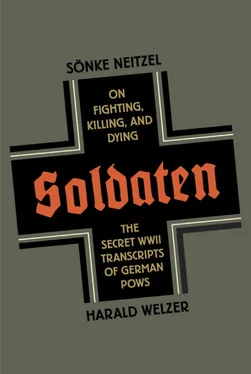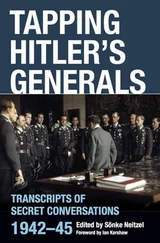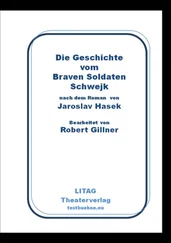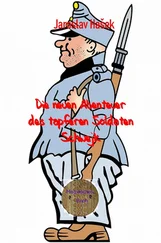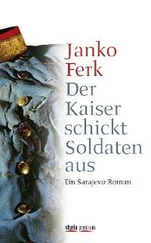On all levels of society, violence was much more present than it is today. Political violence was common in the Weimar Republic, which saw no shortage of brawls at political meetings, street fights between left- and right-wingers, and political assassinations. Moreover, everyday social interactions—between police and detainees, husbands and wives, teachers and pupils, and parents and children—were permeated with physical violence. After taking power, the Nazis further undermined the state monopoly on legitimate force. Para-state organizations like the SA arose alongside the actual state and operated as a kind of auxiliary police force. They exercised massive violence until the summer of 1934 without ever being called to account by the government. We have already discussed the socializing function of violence and its capacity for differentiating groups within a society, and there is no doubt that the violence perpetrated against Jews and other persecuted groups helped raise the level of violence in Nazi society and in the everyday consciousness of its members.
A pilot and low-level officer named Hagen, for example, described the situation as follows:
HAGEN: I took part in all that business with the Jews in 1936—these poor Jews! (Laughter.) We smashed the window panes and hauled the people out. They quickly put on some clothes and (we drove them) away. We made short work of them. I hit them on the head with an iron truncheon. It was great fun. I was in the SA at that time. We used to go along the streets at night and haul them out. No time was lost, we packed them off to the station and away they went. They were out of the village and gone in a flash. They had to work in quarries but they would rather be shot than work. There was plenty of shooting, I assure you. As early as 1932, we used to stand outside the windows and shout: “Germany awake!” {91} 91 SRA 3616, 31 January 1943, TNA, WO 208/4129.
In 1940, violence was far more normal, expected, legitimate, and commonplace than it is today. Moreover, if we consider that significant numbers of people were part of an organization whose very purpose was violent, it is perhaps clearer why many, although not all, German soldiers did not need to get accustomed to violence. Violence was part of their frame of reference, and killing part of their duties. Why should they have seen it as something alien to their self-perception, essence, and intellect? That rhetorical question applies all the more in a case like the Luftwaffe, where violence was carried out with fascinating high-tech tools like fighter planes and strafe bombers and experienced as a highly attractive mixture of ability, technological superiority, and thrill.
The initially surprising discovery that not all German soldiers needed a phase of brutalization is supported by the empirically recorded rise in violence against the civilian population directly after Germany’s invasion of Poland. Women were raped, Jews harassed, and businesses and private homes plundered, much to the consternation of the German military leadership, which issued a number of largely unsuccessful new regulations on conduct. {92} 92 Böhler, Auftakt, p. 181ff.
For example, on October 25, 1939, less than two months after the start of World War II, the commander in chief of the army, General Walter von Brauchitsch, threatened “all those officers who continue to disobey orders and enrich themselves” with dishonorable discharge. “The achievements and success of the Polish campaign,” he wrote,
cannot blind us to the fact that a part of our officer corps lacks a stable internal deportment. There are a considerable number of cases of officers illegally driving people from their homes, confiscating items without permission, enriching themselves by failing to report or stealing goods, mistreating or threatening their inferiors, partly in states of excitement and irresponsible drunkenness, failing to carry out orders with grave consequences for the troops under their command, and committing sexual offenses against married women. The image that results is that of a pack of marauding mercenaries who cannot be reprimanded sharply enough. Whether they are acting consciously or not, these officers are parasites who have no business in our ranks.
Despite this warning, however, Brauchitsch continued to see the need to issue further regulations aimed at maintaining “manly discipline” until the end of 1939. {93} 93 Ibid., p. 185.
The same things true of society at large were also true of the army. People differ, and what for someone like Pohl might have been a source of pleasure could be alien, if not repulsive, to someone like Meyer. Yet because both came from the same institution, the Luftwaffe, and found themselves in the same situation as prisoners of war, their social similarities outweighed their individual differences. Even if Meyer thought his comrade Pohl was a reprehensible swine, Meyer would have likely found Pohl’s anecdotes suitable subject matter for later conversations, along the lines of: “I was interned together with this guy who told of how much he enjoyed hunting down human beings…”
German soldiers rarely used the words “death” and “kill” in their conversation. That may seem surprising since killing is one of soldiers’ central duties and the production of dead enemies is a main result to be achieved. But precisely for this reason, death and killing were rarely subjects of discussion. Just as construction workers tend not to discuss bricks and mortar during their breaks, soldiers seldom talked about killing.
Killing others in battle was so commonplace that it hardly merited discussion. Moreover, except in cases like those of solo fighter pilots, {94} 94 See Kehrt, Moderne Krieger, pp. 403–7.
battle is a heteronomous undertaking that depends more on factors like group strength, equipment, the tactical situation, and the enemy than on the doings of any one individual soldier. Individual soldiers have little influence over whether they kill anyone and, if so, whom, or whether they themselves get killed. Anecdotes about that possess little amusement value and would have required soldiers to talk about emotions like fear and desperation. It was taboo, within the masculine culture of the military, to admit that one had wet one’s pants, vomited in fear, or anything of the kind. Moreover, rehashing things that everyone knows and has experienced for himself (or at least claims to know and have experienced for himself) isn’t good conversation. In normal civilian society, one doesn’t discuss the minutiae of one’s daily work routine or describe the egg one ate for breakfast. A central criterion for a good story, one worth telling and hearing, is something extraordinary, be it especially irritating or welcome, witty, horrible, or heroic. {95} 95 Donald E. Polkinghorne, “Narrative Psychologie und Geschichtsbewußtsein: Beziehungen und Perspektiven,” in Erzählung, Identität und historisches Bewußtsein: Die psychologische Konstruktion von Zeit und Geschichte: Erinnerung, Geschichte, Identität, Jürgen Straub, ed. (Frankfurt/Main: Suhrkamp, 1998), pp. 12–45. See also the excellent study by Stefanie Schüler-Springorum, Krieg und Fliegen: Die Legion Condor im Spanischen Bürgerkrieg (Paderborn: Schoeningh Verlag, 2010), pp. 159–70, 176–80.
People spend very little time talking about normal everyday life. Why should they? Things that were part of the normal lives of soldiers—including death, killing, and injuries—were background that was taken for granted and seldom discussed.
But commonplace routine was only one of the things the soldiers didn’t talk about. Another was emotions, especially those of fear or threat, uncertainty, desperation, or sheer concern for one’s own survival. Such topics rarely crop up in the surveillance protocols, and previous research has shown that soldiers in general filter them out of their conversations. {96} 96 Svenja Goltermann, Die Gesellschaft der Überlebenden: Deutsche Kriegsheimkehrer und ihre Gewalterfahrungen im Zweiten Weltkrieg (Stuttgart: Dt. Verlag, 2009).
Soldiers don’t like talking about death. It’s too real to them. Moreover, just as they only very rarely discuss the all-too-realistic possibility of being killed or wounded themselves, death as a general phenomenon or process seldom occurs in their conversations. In soldier-speak, people are mowed or shot down, drop out of sight, or are simply gone. Obviously, if soldiers were to imagine their own deaths they would have to imagine how they died, and the phenomenon of death, which many of them had experienced often, directly in front of their own eyes, would seem very near. Thus soldiers’ conversations about death and killing revolve around violence of all sorts without ever explicitly mentioning death or killing. Navy men, for instance, describe the success of their efforts in numbers of dead or tonnage of ships sunk. But they rarely speak of who or what it was that they sent to a watery grave.
Читать дальше
